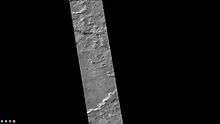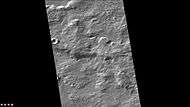Hipparchus (Martian crater)
 Location of Hipparchus Crater | |
| Planet | Mars |
|---|---|
| Region | Phaethontis quadrangle |
| Coordinates | 44°48′S 151°24′W / 44.8°S 151.4°WCoordinates: 44°48′S 151°24′W / 44.8°S 151.4°W |
| Diameter | 93 km |
| Discoverer | Mariner 4 (1965) |
| Eponym | Hipparchus |

Hipparchus Crater is an impact crater in the Phaethontis quadrangle of Mars, located at 44.8° S latitude and 151.4° W longitude. It is 93.0 km in diameter and was named after Hipparchus, and the name was approved in 1973.[1]
Nearby prominent craters include Eudoxus to the east, Li Fan to the west-southwest and Ptolemaeus further west, also further northwest is the larger Newton. Small channels dominate parts of the crater especially its rims.
The first close-up of the crater was discovered by Mariner 4 in 1965 and was the 14th photo taken during its flyby, more details of the crater were first photoed by Mariner 9 in 1971.
Channels
There is enormous evidence that water once flowed in river valleys on Mars.[2][3] Images of curved channels have been seen in images from Mars spacecraft dating back to the early seventies with the Mariner 9 orbiter.[4][5][6][7] Indeed, a study published in June 2017, calculated that the volume of water needed to carve all the channels on Mars was even larger than the proposed ocean that the planet may have had. Water was probably recycled many times from the ocean to rainfall around Mars.[8][9] Some of the pictures on this page show channels in Hipparchus Crater.
 Small channels in Hipparchus Crater, as seen by CTX camera (on Mars Reconnaissance Orbiter). Note: this is an enlargement of the previous image of Hipparchus.
Small channels in Hipparchus Crater, as seen by CTX camera (on Mars Reconnaissance Orbiter). Note: this is an enlargement of the previous image of Hipparchus. Wide view of channels on rim of Hipparchus Crater, as seen by HiRISE under HiWish program
Wide view of channels on rim of Hipparchus Crater, as seen by HiRISE under HiWish program Close view of channels on rim of Hipparchus Crater, as seen by HiRISE under HiWish program
Close view of channels on rim of Hipparchus Crater, as seen by HiRISE under HiWish program Close view of channels on rim of Hipparchus Crater, as seen by HiRISE under HiWish program
Close view of channels on rim of Hipparchus Crater, as seen by HiRISE under HiWish program
See also
References
- ↑ "Gazetteer of Planetary Nomenclature | Hipparchus". usgs.gov. International Astronomical Union. Retrieved 4 March 2015.
- ↑ Baker, V., et al. 2015. Fluvial geomorphology on Earth-like planetary surfaces: a review. Geomorphology. 245, 149–182.
- ↑ Carr, M. 1996. in Water on Mars. Oxford Univ. Press.
- ↑ Baker, V. 1982. The Channels of Mars. Univ. of Tex. Press, Austin, TX
- ↑ Baker, V., R. Strom, R., V. Gulick, J. Kargel, G. Komatsu, V. Kale. 1991. Ancient oceans, ice sheets and the hydrological cycle on Mars. Nature 352, 589–594.
- ↑ Carr, M. 1979. Formation of Martian flood features by release of water from confined aquifers. J. Geophys. Res. 84, 2995–300.
- ↑ Komar, P. 1979. Comparisons of the hydraulics of water flows in Martian outflow channels with flows of similar scale on Earth. Icarus 37, 156–181.
- ↑ http://spaceref.com/mars/how-much-water-was-needed-to-carve-valleys-on-mars.html
- ↑ Luo, W., et al. 2017. New Martian valley network volume estimate consistent with ancient ocean and warm and wet climate. Nature Communications 8. Article number: 15766 (2017). doi:10.1038/ncomms15766